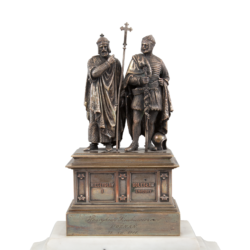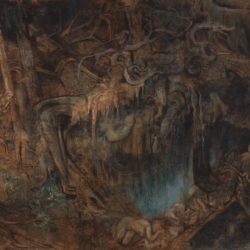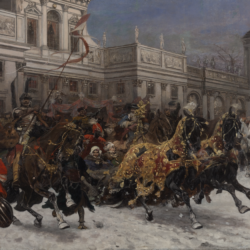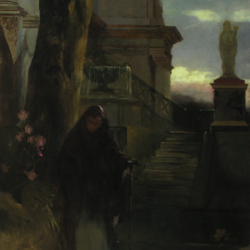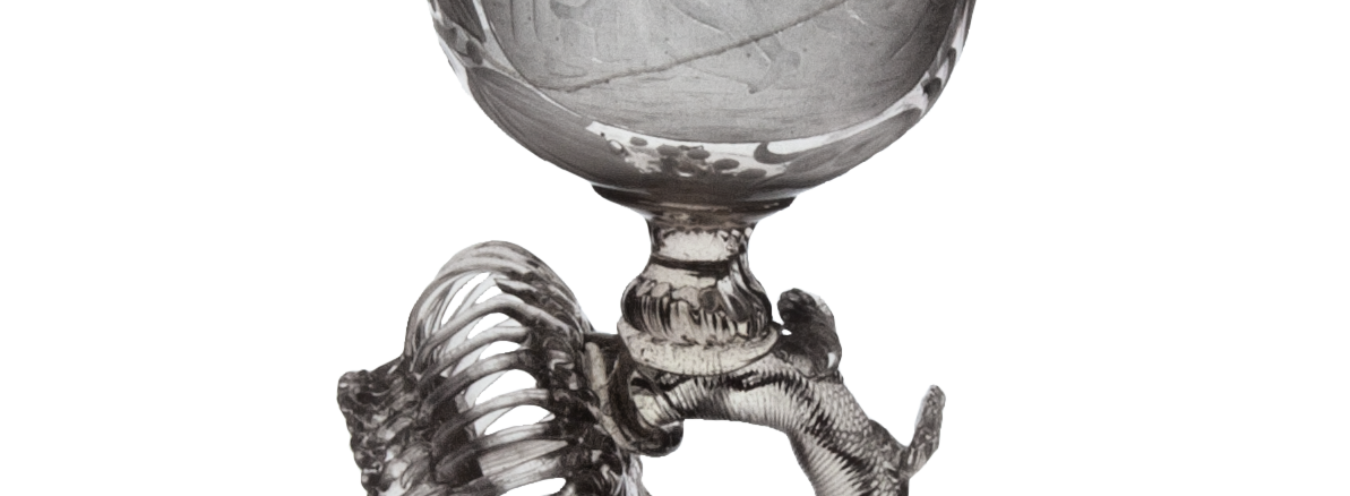
The Historical Novel as a Journey Through The Collective Unconcious
Yet another solution to open up the “Scientist Panopticon cell” was, obviously, to present history as a large field of possibilities such as a miscellaneous collection of “scenes of freedom” proposed by Hans-Georg Gadamer in his hermeneutical conception of history. This open field has a potential for many different developments, and strangely enough, a lot of them are determined by decisions of individuals. That is probably why, among Sienkiewicz’s works that precede the Trilogy, many critics have singled out a novella entitled Tartar Captivity (Niewola tatarska). The story has been discussed by Tadeusz Bujnicki[1] and, more recently, by Marek Wedemann[2]. Critics unanimously point to the connection between Sienkiewicz’s work and The Constant Prince by Calderon de la Barca. As the latter was translated into Polish by the leading poet of Polish romanticism Juliusz Słowacki, we may infer a romantic influence and a certain inclination on the part of Sienkiewicz to seek inspiration in pre-modern times, when (as the writer himself would probably say) great people, filled with fiery passions and unswervingly faithful to their duty still lived. Bujnicki marks the novella’s consideration of the issue of national and religious treason as well as of historical legacy guardians, capable of passing the values on to the rest of the society and thus (in terms of political theology) developing the public’s sensitivity to the transcendent order as the paradigm for both the human soul and the social hierarchy. This is precisely the role performed by the protagonist of Tartar Captivity, a representative of the Polish gentry, Aleksy Zdanoborski, who shows commoners (his fellow captives) the meaning of steadfastness by refusing to convert to Islam or offer his voluntary service to the khan.
Clearly, Sienkiewicz’s later historical works incorporate the same vision of the Polish nation, based on the patriotism of the nobility (or, more generally, of historical legacy guardians) who should set an example of proper conduct for the rest of the society; the society, in turn, should follow it, just like the human soul follows a transcendental inspiration. There is no doubt that the author makes up his mind here about the way to disseminate patriotism and the sense of national identity among the general public, a process that historians of ideas and political scientists regarded to be inevitable after the French Revolution of 1789. According to Sienkiewicz, this process should not undermine the authority so that patriotism (or national awareness) and revolution do not form a combination which threatens so many modern societies[3].
It is worth noting that, in Tartar Captivity as well as in numerous incidents throughout the Trilogy, in different variations, this emanation of authority from truly honorable guardians of historical legacy (in contrast to undeserving usurpers) is actually enhanced by situations such as traumatic oppression, ethnic persecution, and even major internal conflicts comparable to a civil war. This entails one more important aspect, connected with the fortunes of the human soul in the epoch of godlessness. In the seminal proto-Enlightenment political theory of Thomas Hobbes, elaborated in his Leviathan, the key role is ascribed to social chaos, “a condition of war of everyone against everyone.” It was precisely the threat of war and traumatic memories of turbulent interregna that forced primeval societies to opt for cooperation and submission to an authority. The democratic public sacrifices part of its freedom in exchange for guardianship and protection of their lives. As explained by Voegelin, the Enlightenment was the time when:
the orientation toward a summum bonum was replaced by the flight from the summum malum of death in civil war. The inversion of direction becomes now established, under the title of genealogy, as the principal instrument for interpreting the internal order of human nature. […] the strata of human nature are interpreted genetically as derivatives of a physical or biological substance at the bottom of existence. […] in Hobbes we already see the dangerous attempt to replace the spiritual process of contrition by the external process of submission to governmental power[4].
It is possible that Sienkiewicz evoked the difficult, often traumatic experiences of the past not only “for the strengthening of hearts” (as the author wrote himself at the end of the Trilogy) but also to stir the readers’ souls on an individual, not just community, basis. If, indeed, the order imposed in modern societies had its roots in the fear of summum malum (i.e., war or revolution), and these societies were affected by the loss of their religious integrity on an individual, personal level, then the depiction of the “re-integration” model could have had a therapeutic effect. Perhaps it was this tendency (as described by Voegelin) that inspirited Sienkiewicz to demonstrate the following assumption: any state of social chaos or lawlessness can be overcome by a soul that holds – both on individual and communal levels – unto moral values.
Following their original publication in the 19th century, the Trilogy and other works by Sienkiewicz have fulfilled a therapeutic role, showing in very concrete terms that – despite its shortcomings, miseries, and historical defeats – Polish society can be reborn, and its representatives have a potential to change for the better. Consequently, Sienkiewicz’s oeuvre has had a much more positive impact on readers than the output of the advocates of progress and the adoption of Western paradigms (which all too often meant going against the national psychology). Instead of the utopian ideal of bringing happiness to mankind through science and rational skepticism, Sienkiewicz proffered the belief that, irrespective of the future which awaited Poles, they would always be able to rise to the challenge with their spiritual and mental strength, built up from past experiences. It is the common past that gives the nation the vigor to adapt to the vicissitudes of life.
Incidentally, anthropologists distinguish an important healing technique used by witch doctors in so-called “primitive cultures,” which consists in forcing the patient (under the spell of the “evil spirits” of the past) to abreact traumatic experiences in a sort of a theatrical performance. The haunting event is reenacted so that the patient is able to recover from the trauma by undertaking adequate steps instead of the former mistakes that led to the tragedy. Then and only then can the healing begin, and the patient can get over the trauma[5].
Sienkiewicz’s letters from his voyage to America, written for and published in the Warsaw press, testify to the writer’s keen interest in Native Americans. Meeting them – even if they were, e.g., prisoners escorted by American troops – was a major source of excitement. Literary historians claim that the author of the Trilogy drew an analogy between the enslaved, rebelling Poles and Native Americans in their fight against the overwhelming forces of white invaders. It is said that, during his stay in Anaheim, California, Sienkiewicz often went for lonely horseback rides. Though there is no evidence to support this guess, it would not be inconceivable to imagine that he spent this time visiting a nearby Indian Reservation, talking to the shamans, and trying to learn the difficult art of summoning the ghosts of ancestors[6].
According to one of the most famous quotes from Eric Voegelin, “the order of history is the history of order” – i.e., of developing both the perception and the notion of order with regard to religion and philosophy. This reversal of terms may seem to be of little significance, but in fact, it brings back the primacy of eschatology into the perspective of post-Enlightenment immanentism and, therefore, is a sort of settlement with 19th-century Historicism and its Enlightenment roots. In his study on Sienkiewicz’s conversion to conservatism, Tadeusz Bujnicki cites the anti-positivist turn as an explanation of the mystery behind the novelist’s conversion, or, to be more precise, behind him putting one foot on both sides of the ideological barricade (which could be illustrated by the fact that, even when writing the first part of the Trilogy, Sienkiewicz expressed anticlericalism in his letters; opposition to the clergy was a classic trait of progressive positivist thought, but the writer was already known at that time as the opponent of positivism).
It is important to note here that the anti-positivist turn also impacted clerically-minded conservatives (such as Teodor Jeske-Choiński) without giving rise to ambivalence; at the most, it pushed them towards post-Darwinian nationalism. The different ways in which the cultural phenomenon of turning away from positivism influenced the two historical writers confirm the significance of endorsing (as Jeske-Choiński, also as a potential follower of Wilhelm Dilthey) or opting out of (in the case of Sienkiewicz) the legacy of modern Historicism, where – in line with the Hegelian system, popular throughout the 19th century – it is history that determines the system of values and the vision of the eschaton[7]. It goes without saying that political theology offers a contrary perspective by placing the cultural source of order firmly outside the historical reality. This statement can be tested against the source material of various depictions of historical reality written by Sienkiewicz. The results could reveal, for example, that discarding Historicism through placing the core of historical meaning not in abstraction, but in a specific, unique Bios of a nation, its language and value system, makes it possible for the writer to abandon the most evident romantic narrative structures.
Przypisy
- T. Bujnicki, Sienkiewicz i historia. Studia [Sienkiewicz and history: Studies], Warsaw 1981.
- M. Wedemann, “Niezłomność. O „konserwatyzmie” Henryka Sienkiewicza (na przykładzie Niewoli tatarskiej)” [Steadfastness: On Sienkiewicz’s conservatism in Tartar Captivity], in W kręgu młodokonserwatyzmu warszawskiego 1876–1918 [In the circle of young conservatives in Warsaw, 1876–1918], pp. 73–92.
- Eric Voegelin identifies the sources of the process (the integration of the increasingly wider, democratized sense of social identity, and revolution as the dismantling of the existing order) already in the Enlightenment thought of d’Alembert in “the sentiment of revolt in the sense of an immediate, violent reaction against a social state that is experienced as oppressive. We have seen that d’Alembert has no direct access to the idea of justice; the primary experience is that of oppression” (E. Voegelin, op. cit., p. 78). In this way, the historian exemplifies the fact that some Enlightenment thinkers believed it did not take long to replace the philosophically discarded authority with bitter disappointment and the wrath of common people.
- E. Voegelin, op. cit., p. 69.
- See E. Fuller Torrey, The Mind Game: Witchdoctors and Psychiatrists, New York 1972.
- Interestingly, if we assume Sienkiewicz’s general adherence to the Positivist intellectual background and the validity of Voegelin’s compelling argument that Positivism was a religion of immanence, then we can claim a similar evocation of the “specters of the forefathers” constituted an integral element of Auguste Comte’s concept of Humanity as the Grand-Être: “in its vast majority [Humanity – M. P.] is composed of the dead who are the only ones who can be truly judged. The living are admitted on probation only and the whole of their lives will prove whether they will be permanently incorporated into it or rejected” (E. Voegelin, op. cit., p. 163).
- Sienkiewicz’s opposition to the typically 19th-century Historicism, tainted with Scientism (whether in its abstract Hegelian or the Positivist, factual and evolutionary variety) would put the writer close to Nietzsche – though, of course, one should bear in mind the fundamental difference: their radically divergent approaches towards Christianity.

